Bo Henriksen’s arrival at FSV Mainz has brought a fresh tactical approach to the Bundesliga side. Known for his high-energy coaching style and emphasis on aggressive, organized football, Henriksen has quickly implemented key strategic principles to stabilize and improve the team. Mainz, a club that thrives on intense pressing and collective discipline, appears to be an ideal match for his philosophy.
In this tactical analysis, we break down Henriksen’s approach, examining how his preferred structures, pressing strategies, and attacking patterns influence Mainz’s performances. By analyzing key matches and in-game scenarios, we gain insights into how he adapts to different opponents and situations. How has Henriksen reshaped Mainz’s tactical identity? Let’s take a closer look.
Build-up
Low Build-up
In the low build-up, Henriksen usually sets his team up in an asymmetrical 1-4-2-2-2 formation, with a back four, two holding midfielders, two attacking midfielders, a right-winger, and a striker.
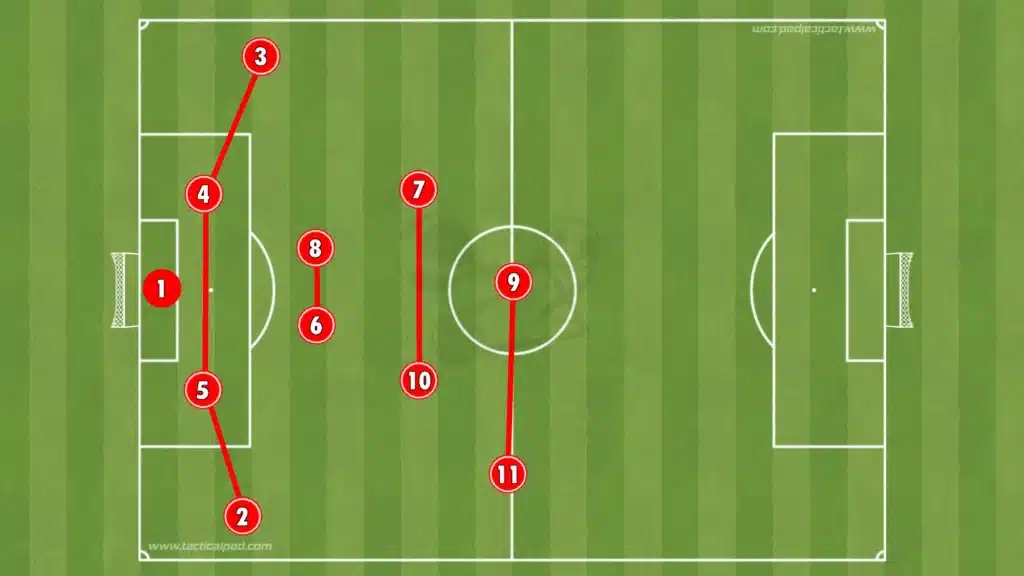
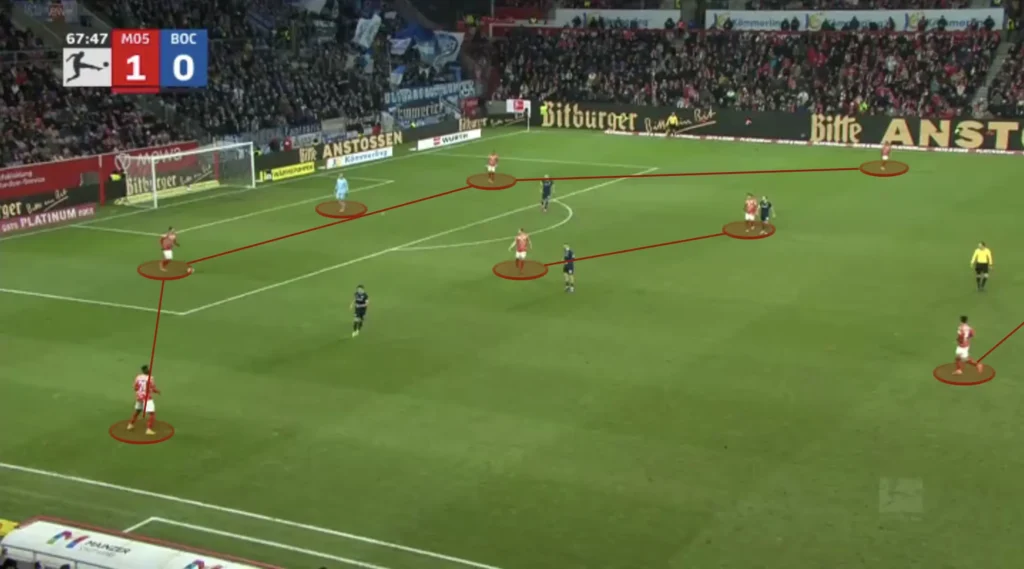
Direct
They often take a direct approach in their build-up play, frequently opting for early long balls to target striker Joshua Burkhardt. Rather than building through short passes, Mainz’s strategy aims to bypass the midfield and immediately create pressure on the opposition’s backline. By sending early balls up to Burkhardt, who is skilled in holding up play and winning aerial duels, they establish a platform from which Mainz can quickly transition into attacking phases. This tactic not only leverages Burkhardt’s physical presence but also keeps the opposition on alert, disrupting their defensive structure and allowing Mainz’s supporting players to move into advanced positions.
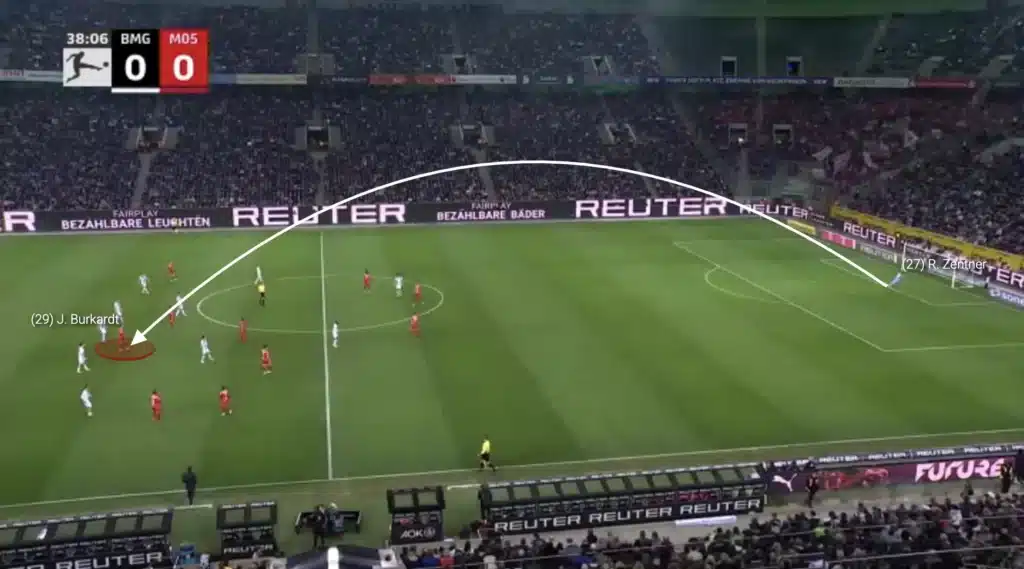
This approach allows Mainz to quickly progress the ball up the pitch while minimizing the risks associated with slow, possession-based build-up.
High Build-up
In the high build-up, Henriksen wants his team to play in a 1-3-4-3 formation.

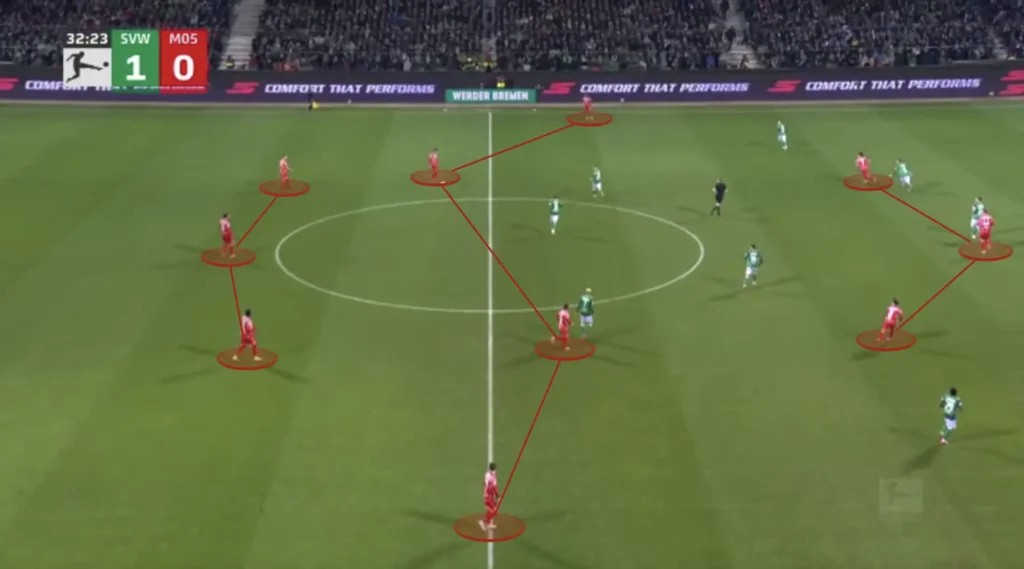
Building up in a 1-3-4-3 formation focuses on creating numerical superiority in the midfield while maintaining width through the wingbacks. The three center-backs provide a solid defensive base, with the central center-back often stepping into midfield to support build-up play. The two wide center-backs spread out to stretch the opposition’s press, creating space for the wingbacks to push up and occupy the flanks. In midfield, the double pivot provides passing options and ensures control in the center, while the front three stay high and centrally, ready to exploit any gaps in the opposition’s defense. This setup allows for fluid ball progression, quick transitions, and the ability to shift play across the pitch, making it difficult for the opposition to predict and intercept passes.
Rotations and Fluidity
Henriksen’s Mainz are highly flexible in their attacking structure, constantly adjusting their shape through intelligent rotations to manipulate the opposition and create space. While they build up in a 1-3-4-3, they frequently shift into different structures as they advance up the pitch. One common adjustment is forming a diamond in midfield, with one of the pivots pushing higher into a number-ten position. This creates more passing angles in central areas, allowing Mainz to overload the midfield, progress the ball more effectively, and break opposition lines.
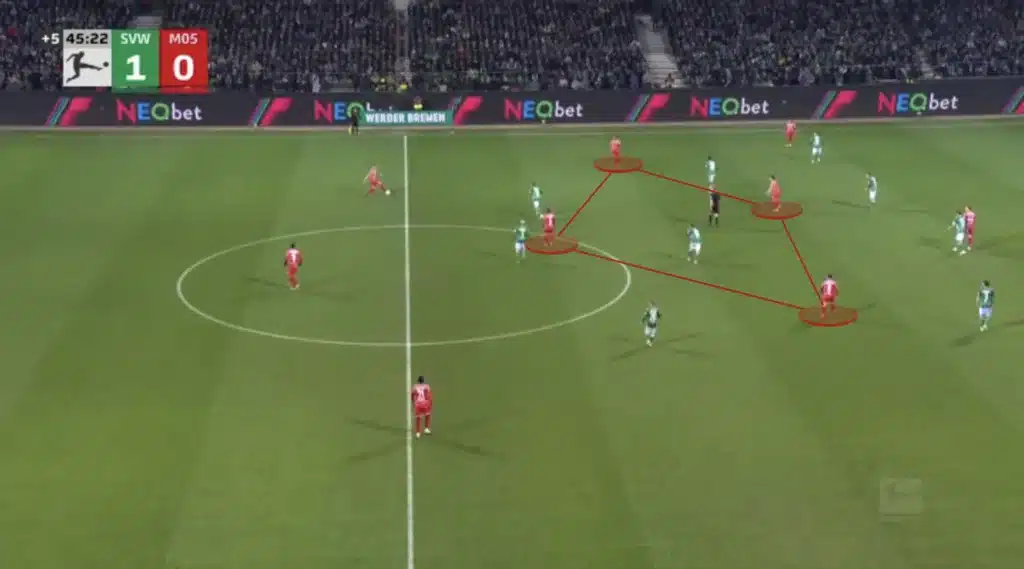
Another key rotation is the dropping movement of one of the holding midfielders into the backline. By stepping into a deeper position, they transform the back three into a temporary back four, offering more stability in possession and better coverage against counterattacks. This also provides the wingbacks with more freedom to push higher, ensuring width in attack while allowing the front three to stay narrow and threaten the opposition’s defensive line.
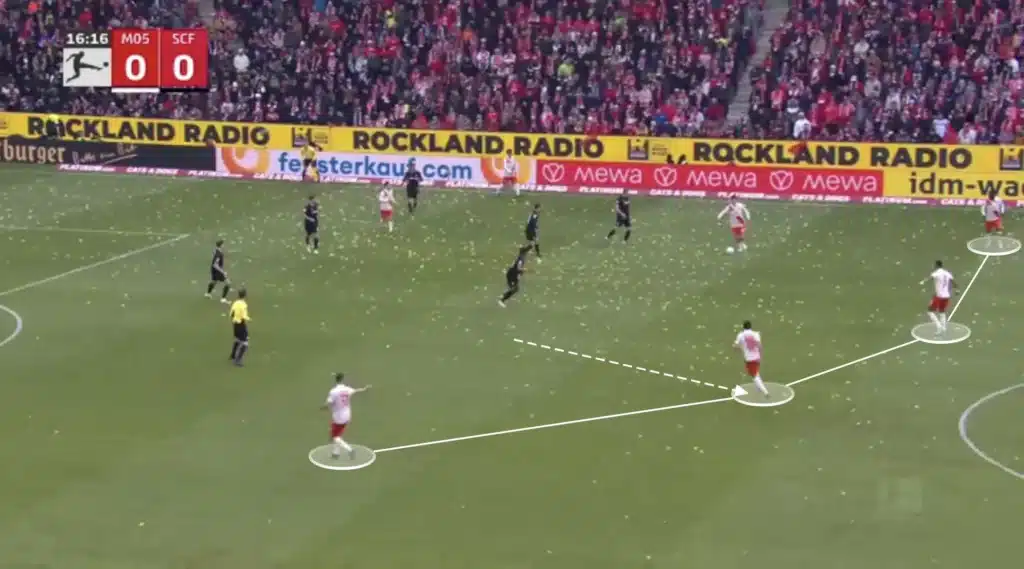
While it demands a lot of technical and tactical skill from the players, these fluid movements make Mainz unpredictable in possession, enabling them to adapt dynamically based on the game situation and the opponent’s defensive setup.
Linking with the Striker
Henriksen often uses the striker Burkhardt to link the play when trying to break down the opposition’s defense. He likes to create central overloads when attacking the opposition and, therefore, often wants Burkhardt to drop from his striker position into the midfield. When the striker drops, Mainz unlock more ways of beating the opponent’s defense. They can, for example, pass the ball to the striker, who can find a midfielder or winger behind the opposition’s midfield line, allowing them to take the ball forward and attack the opposition’s defense.
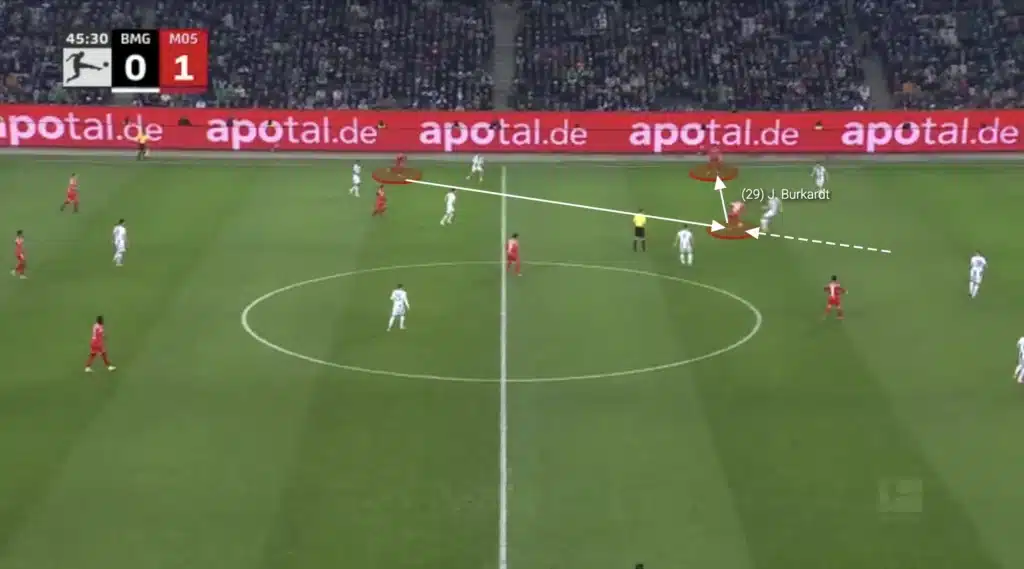
These passing combinations become even more effective when Mainz utilize third-man runs from their midfielders.
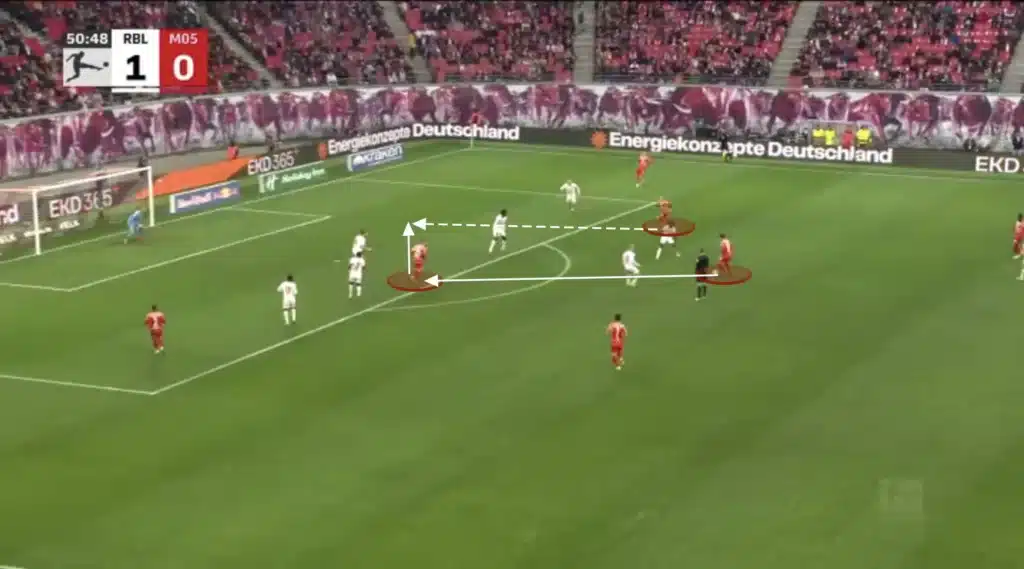
Counter-Movements
A key aspect of Mainz’s attacking play under Henriksen is the use of counter-movements to create space for their dropping striker. When Burkhardt drops into midfield to link play, he is not doing so in isolation—his movement is often complemented by a teammate making a simultaneous run in behind. These counter-movements disrupt the defensive line, forcing defenders to make quick decisions and opening up different attacking options for Mainz.
For example, as Burkhardt drops, one of the attacking midfielders will immediately make a vertical run beyond the defense. This movement stretches the backline and prevents opposition center-backs from stepping up too aggressively on the striker. If a defender does step forward, the runner in behind can receive a through-ball and attack the space. If the defense holds its shape, Burkhardt has more time and space to receive, turn, and pick out a pass.
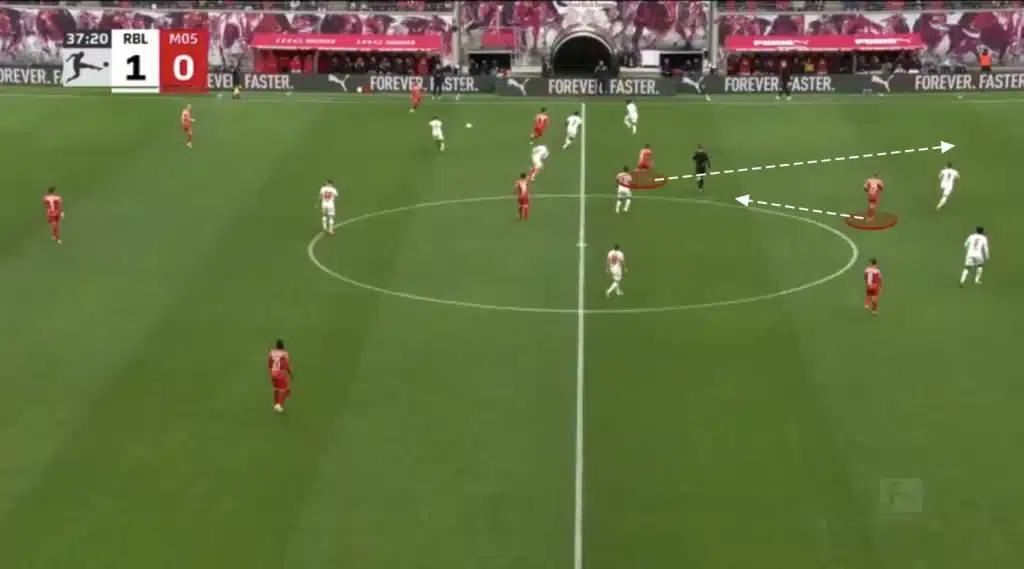
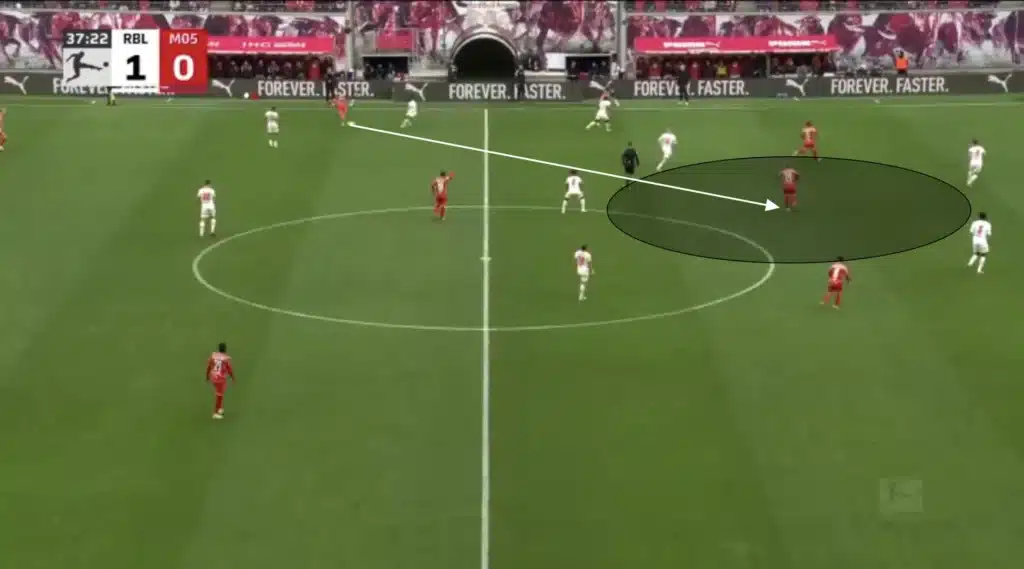
Crossing
Under Bo Henriksen, Mainz have placed a strong emphasis on scoring goals through crosses, utilizing a variety of deliveries from different areas of the pitch. Whether from deep positions, the byline, or even half-spaces, Henriksen’s side looks to create chances by supplying the box with well-timed deliveries aimed at their aerial threats.
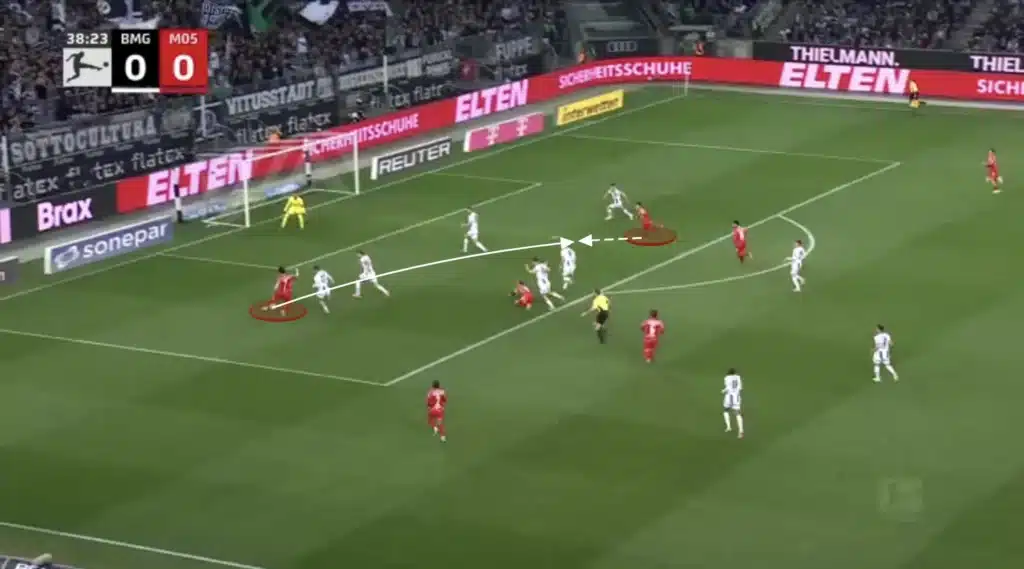
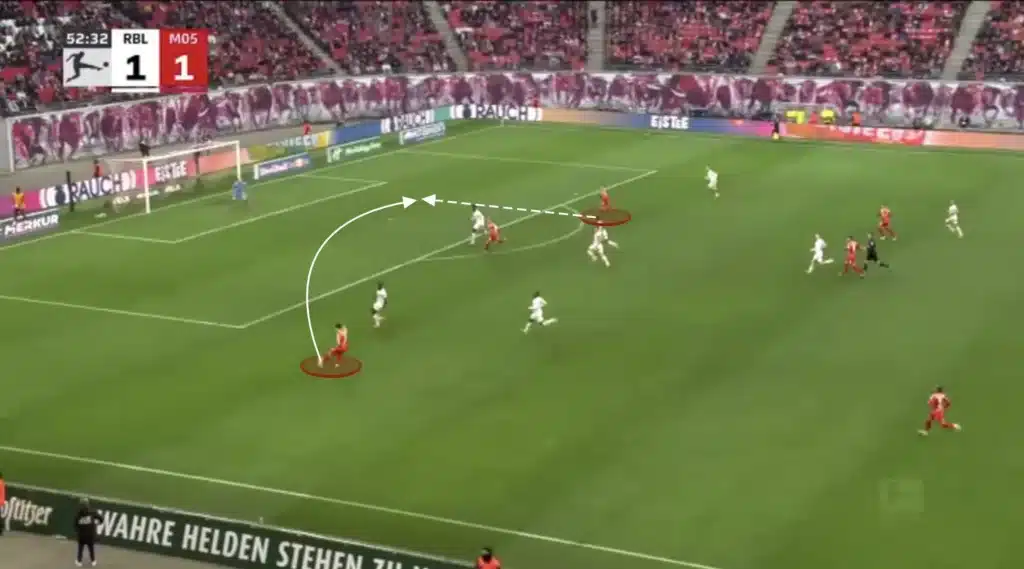
The wingbacks play a crucial role in this approach by frequently pushing forward to whip in crosses. However, Mainz’s crossing strategy is not limited to traditional wide areas—central midfielders and even center-backs can also deliver balls into the box from deep. Henriksen ensures that multiple players make aggressive runs into the penalty area, increasing the chances of converting these deliveries.
This crossing-heavy approach suits Mainz’s physical and hard-working squad, with attackers and midfielders often positioned to attack the ball aggressively. Whether it’s a floated cross to a target man, a driven low ball across the face of goal, or a cut-back from an overlapping wingback, Mainz’s attacking patterns revolve around creating high-quality chances from wide areas.
Many Players in the Box
Henriksen also emphasizes getting multiple players into the box, creating a chaotic environment for the opposition defenders, and increasing their chances of scoring. The attackers and midfielders look to make aggressive runs into the box when the ball is in the final third, often getting four or five players into these areas to create overloads.
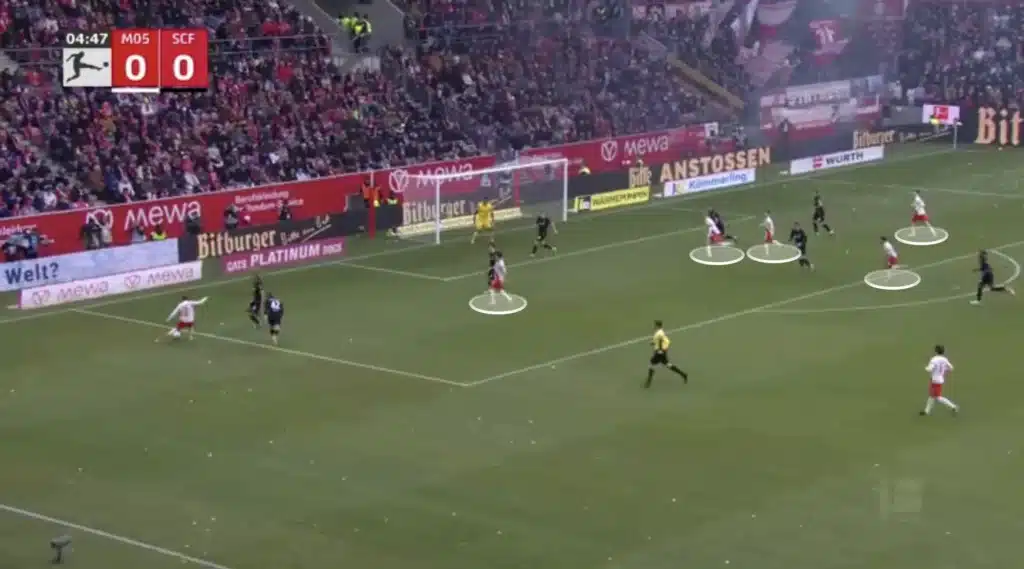
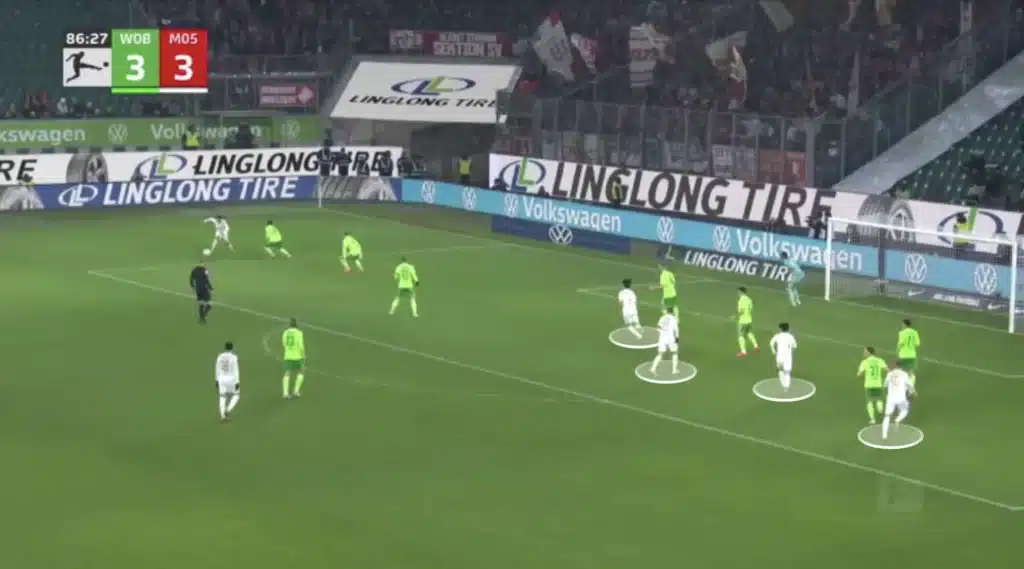
The numerical advantages in the box increase the chances of connecting with the cross, as more players present multiple targets for the crosser, making it harder for defenders to mark everyone effectively. Additionally, having multiple players in the box provides options for different types of finishes, whether it’s a header, volley, or a quick tap-in. It also allows for better positioning to react to second balls or rebounds, increasing the likelihood of capitalizing on any defensive errors.
Henriksen also positions many players outside the box, ready for the second balls and cut-backs. When Mainz create crossing opportunities, the opposition defense drops back, which opens the space in front of the backline. The central midfielders can collect any loose balls or be found directly in these spaces with cut-backs, and from there, they can shoot or combine with an attacker to create goalscoring opportunities.
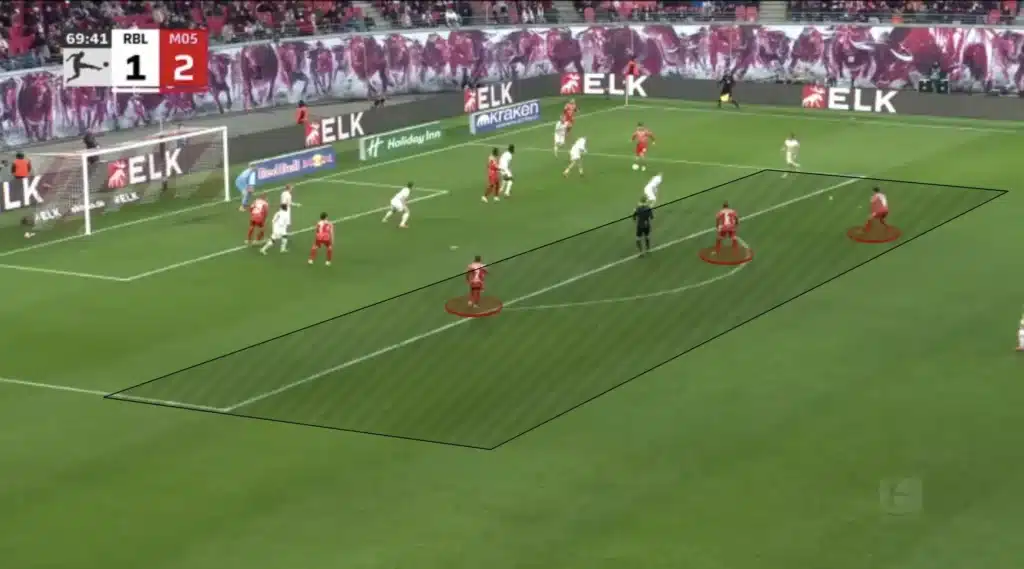
Defending
Henriksen’s Mainz uses a 1-5-4-1 formation when defending. They look to set up in a low-block, always trying to close the center and force the opposition out wide.

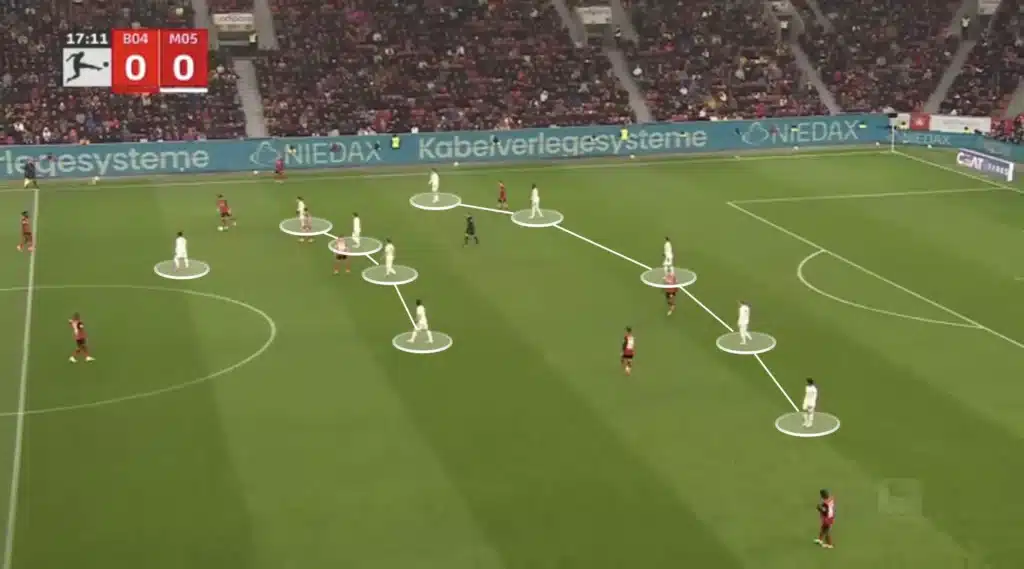
Defending in a 1-5-4-1 formation emphasizes solidity and compactness, making it particularly effective against teams that rely on wide play or quick transitions. The five defenders, including three center-backs and two wing-backs, create a strong defensive line that can absorb pressure and cover the width of the pitch. The four midfielders in front of the backline provide an additional layer of protection, often pressing the ball and cutting off passing lanes, while also helping to maintain the team’s shape. The lone striker remains higher up the field and usually tries to push the opposition to one side. This formation aims to limit the opposition’s space, forcing them to take risks or attempt crosses, which can be more easily defended with the numbers in the box.
While Henriksen’s Mainz primarily defends in a compact 1-5-4-1 formation, they often adapt by pushing one of the central midfielders up to apply pressure on the opposition’s ball carrier. This proactive move is aimed at preventing the team from becoming too passive and allowing the opponent to build up momentum.
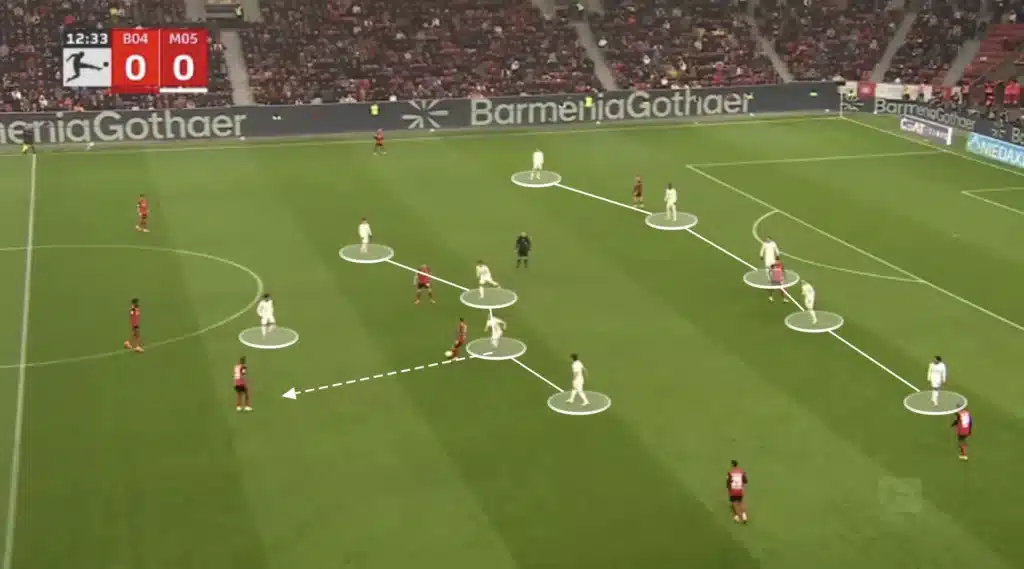
When the central midfielder advances, the remaining midfielders quickly adjust by dropping deeper to cover the space left open. This coordinated movement temporarily shifts the defensive shape to a 1-5-3-2 formation. The remaining midfield trio maintains compactness, ensuring that central areas remain well-protected while also being prepared to shift horizontally to cover wide threats.

High Press
Henriksen also implements a high-pressing system designed to disrupt the opposition’s build-up and force turnovers in dangerous areas. Their pressing structure will depend on the opposition, but they usually press in an aggressive man-to-man system. Each player is assigned a direct opponent to mark tightly, ensuring no easy passing options are available.
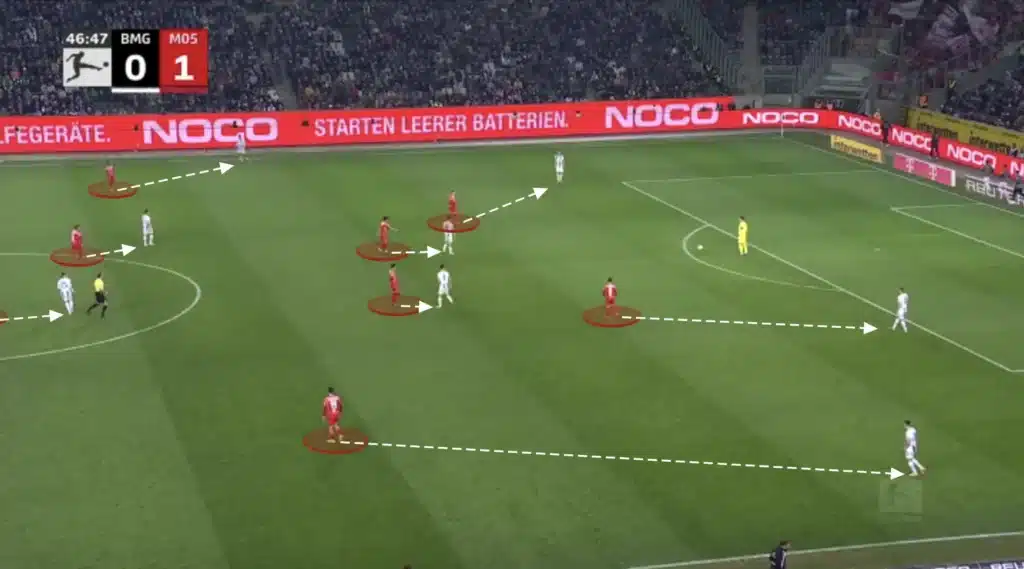
This intense pressure forces the opposing team into hurried decisions, often resulting in turnovers in dangerous areas. Mainz almost use this high press as an attacking threat, scoring many goals from winning the ball high up the pitch.
In a man-to-man system, it becomes crucial that the players know when to mark the opponent they are responsible for and when not to. If an opponent, for example, is very far from the ball, the Mainz player marking him does not need to be as close to him. He can instead come in and help create numerical superiorities in the center, decreasing the risk of dangerous 1v1 situations. In this situation, the opposition plays a long ball. The Mainz midfielders leave their opponents and drop back to be first to an eventual second ball.
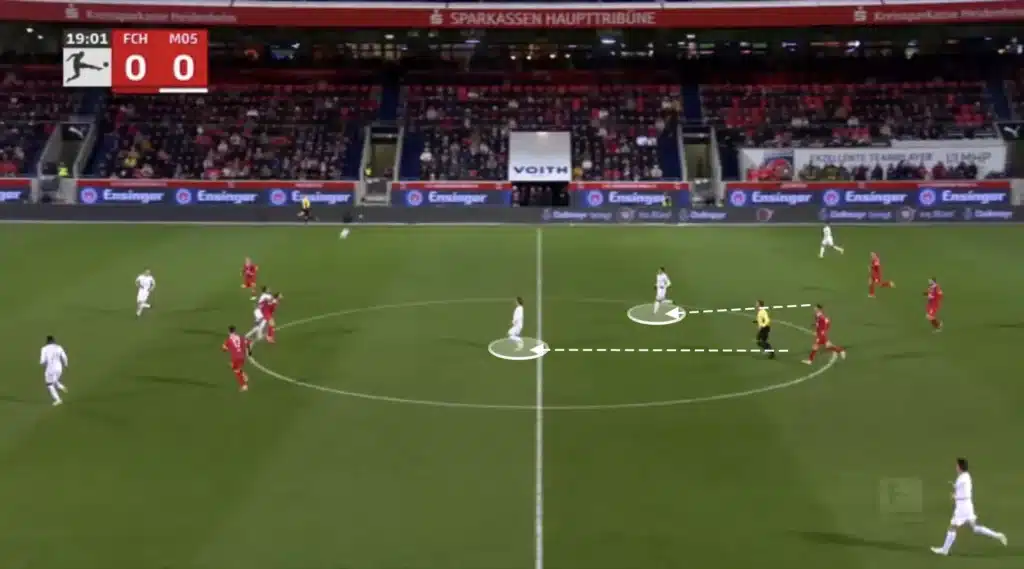
The Mainz players will always have an opposition player they are responsible for. However, they will never be closer to them than they need to be. A rule of thumb for the players could be that the closer you are to the ball, the closer you need to be to your opponent. The further away you are from the ball, the further away you can be from your opponent.
Transitions
Defensive Transitions
Mainz are great in defensive transitions. In possession, they always have many players high up and close to the ball, which creates good conditions for counterpressing. Many players close to the ball after losing possession means that many players can work towards regaining possession. Henriksen’s players are also very aggressive in the first seconds after losing the ball. The four or five players closest will immediately jump on the opposition player with the ball and close the distance to cut off any passing lanes. This approach disrupts the opponent’s transition from defense to attack, forcing errors and creating opportunities to regain control in dangerous areas.
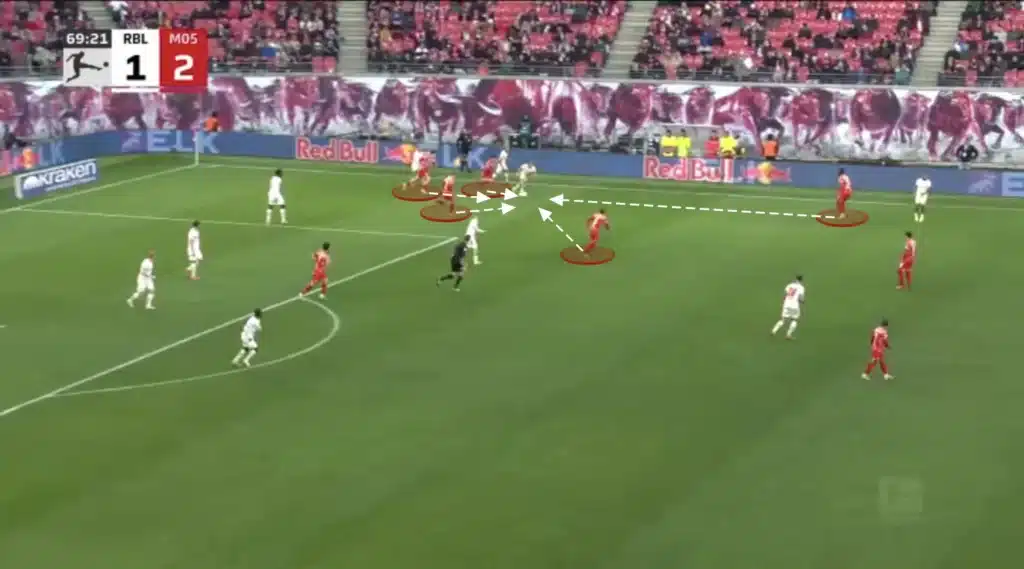
Counterpressing like this keeps Mainz on the front foot, allowing them to dominate possession and create more scoring opportunities. However, it requires exceptional fitness, tactical discipline, and teamwork.
Offensive Transitions
Henriksen also wants his team to counterattack in their offensive transitions. When winning the ball, the team transitions quickly from defense to attack, utilizing the speed and movement of their forward players. Henriksen emphasizes vertical passes to exploit spaces left by the opposition, often targeting wide areas or gaps between defenders. Mainz’s counterattacks are well-organized, with players making intelligent off-the-ball runs to create overloads and support the ball carrier. This quick, direct style catches opponents off guard, making Mainz a dangerous team on the break.
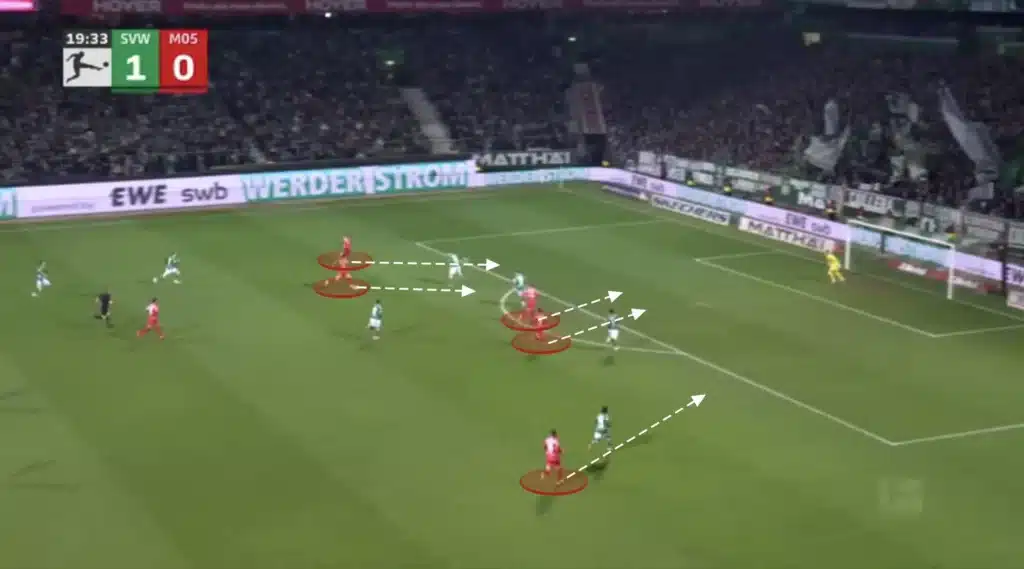
Additionally, the Mainz players are great at finding open spaces in the counterattacks. Instead of playing the ball straight forward where opposition defenders may still be positioned, they play a diagonal pass, allowing the team to bypass pressure and shift the play into open areas. From these areas, the Mainz attackers can take the ball forward and quickly get past the opposition to create a goalscoring opportunity.
Final Thoughts
Bo Henriksen’s impact on FSV Mainz is already evident, with his tactical approach bringing structure, intensity, and adaptability to the team. His emphasis on high pressing, vertical transitions, and compact defensive organization aligns well with Mainz’s identity, making them a difficult opponent to break down. While challenges remain, particularly in maintaining consistency and adapting to different opposition setups, Henriksen’s philosophy provides a clear framework for long-term success.
As Mainz continues to evolve under his leadership, it will be interesting to see how his tactical principles develop and whether he can push the team to greater heights in the Bundesliga. If Henriksen can refine his strategies while maintaining the team’s trademark intensity, Mainz could establish itself as one of the most tactically disciplined sides in the league.
